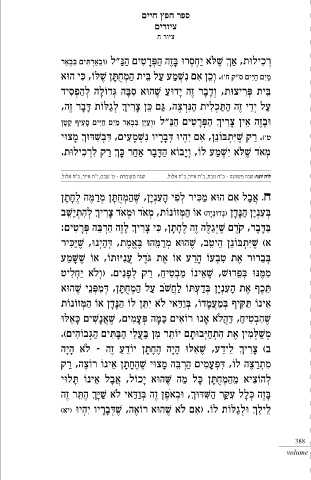Page 398 - V4
P. 398
Sefer Chafetz Chayim םייח ץפח רפס
Ilustrative Examples םירויצ
Example 9 ח רויצ
father in law is going to deceive the groom regarding the dowry ראבִבּ םיִתּרְאבוּ( ל"נּה םיִטרְָפּה הזבּ וּרסחי אלֶֹּשׁ ךְא ,תוּליִכרְ
ְ
ַ
ְ
ָ
ֶ
ַ
ַ
ַ
ַ
ֵ
ֵ
ְ
ַ
or his promised level of support for the couple, then the observer’s
ֵ
ֻ
ַ
ֵ
ַ
ְ
ַ
ִ
“report” to the groom is conditional. If he determines (13) his report אוּה יִכּ ,וֹלֶּשׁ ןָתּחְמה תיבּ לע עמְשׁנ םִא ןכו .)'ח ק"ס םיִיַּח םִיַמ
will be accepted by the groom but only in regard to suspecting the דיִסְפהל הלוֹדגּ הבִּס אוּהֶשׁ עוּדי הז רבדו ,תוּצירְִפּ תיבּ
ָ
ָ
ְ
ָ
ַ
ֶ
ְ
ַ
ָ
ְ
ָ
ֵ
veracity of the report, meaning that he will seek advice to counter
ַ
ִ
ָ
ֶ
ְ
ָ
ַ
ֵ
ָ
ְ
ַ
ֶ
ַ
ַ
ֶ
ְ
the father(’s deception) so that he will not be able to cheat him, ,הז רבדּ תוֹלּגל ךְירִצ ןכּ םגּ ,הצרְנּה תיִלכַתּה הז ידֵי לע
or that the groom will not initiate any action himself except to ןטקָ ףיִעס םייּח םימ ראבִבּ ןיּעו( ל"נּה םיִטרְָפּה ךְירִצ ןיא הזבוּ
ָ
ָ
ֶ
ַ
ַ
ֵ
ַ
follow the decision of the Beit Din, (then under these conditions) ָ ָ ִ ַ ִ ַ ֵ ְ ֵ ַ ְ
ְ
ֵ
ְ
ִ
ִ
ִ
ָ
ָ
ְ
ִ
ָ
it is permissible to make this disclosure to the groom. However, יוּצמ ךְוּדִּשׁבדּ ,םיִעמְשׁנ וירָבדּ וּיהי םִא ,ןנוֹבְּתיֶּשׁ קרַ .)'ט
the speaker must be careful not to neglect any of the conditions
ַ
ַ
ָ
ָ
ָ
ָ
ַ
ַ
ִ
ְ
th
nd
described above in the 2 halacha of the 9 Kelal. Also, it seems to .תוּליִכרְִל קרַ ךְכּ רחא רבדּה אוֹביו ,וֹל עמְשׁי אלֶֹּשׁ דֹאְמ
me that the speaker must fulfill the third condition described above,
namely that he knows there is no deception on the part of the groom. .לולא ח"כ ,רייא ח"י ,טבש 'ט - תרבועמ הנש .לולא ח"כ ,רייא ח"כ ,תבט ח"כ - הטושפ הנש :ימוי חול
But if this observer \ speaker foresees the groom will completely
believe his report and because of that report he will unilaterally ןָתחל המּרְַמ ןָתּחְמהֶשׁ ,ןינִעה יִפל ריִכּמ אוּה םִא לבא .ח
ָ
ֻ
ָ
ֲ
ָ
ֶ
ְ
ֶ
ָ
ַ
ְ
ַ
break off the engagement without any valid halachic claim, then the
ְ
ָ
ַ
ַ
ַ
ָ
ַ
ָ
ְ
ְ
ְ
ְ
ָ
speaker is forbidden to report anything to the groom (14) since it is בֵשּׁיְתִהל ךְירִצ דֹאְמוּ דֹאְמ ,תוֹנוֹזְמּה וֹא )הינוּדנ( ןדנּה ןינִעבּ
not possible to fulfill all of the conditions for disclosure. Please see :םיִטרְָפּ הבּרְה הזל ךְירִצ יִכּ ,ןָתחל הז הלּגיֶּשׁ םדֶקֹ ,רבדּבּ
ַ
ַ
ָ
ְ
ֶ
ָ
ָ
ֶ
ָ
ֶ
ָ
ַ
ֵ
ֶ
the Be’er Mayim Chayim.
ִ
ֶ
ֵ
ְ
ְ
ֵ
ַ
ריִכּיֶּשׁ ,וּניהדּ ,תמאבּ וּהֵמּרְַמ אוּהֶשׁ ,בֵטיה ןנוֹבְּתיֶּשׁ )א
ֶ
ַ
ֱ
ִ
ַ
ֶ
עמָשֶּׁשׁ וֹא ,וֹתוּיּנֲע לדֶֹגּ תא וֹא ערַה וֹעבִט תא רוּרבבּ
ְ
ֶ
ְ
ָ
ֵ
Be’er Mayim Chayim
ַ
ְ
טיִלחי אלֹו( .םינפל קרַ ,חיִטבמ וֹניאֶשׁ ,שׁוּרפבּ וּנּמִּמ
ֵ
ַ
ְ
ְ
ֵ
ְ
ִ
ַ
ֶ
ְ
ָ
(E3/9/1)-(13) .. If he determines: Please reference above the Be’er
ֶ
ָ
ְ
ֶ
ֵ
ְ
ַ
ֻ
ְ
ַ
ָ
ֲ
ַ
th
th
Mayim Chayim of the 9 Kelal, in the 16 notation. אוּהֶשׁ ינְפִּמדּ ,ןָתּחְמה לע בֹשׁחל וֹתְּעדַבּ ןינִעה תא ףכֵתּ
(E3/9/2)- (14) .. then the speaker is forbidden to report תוֹנוֹזְמּה וֹא ןדנּה וֹל ןֵתּי אלֹ יאדּובּ ,וֹדמֲעמבּ ףיִקַּתּ וֹניא
ֵ
ַ
ָ
ִ
ַ
ָ
ְ
ַ
ַ
ָ
ַ
ְ
anything to the groom: Even if all of the conditions of the 2 halacha
nd
ָ
ְ
ָ
ֵ
ַ
ָ
ָ
ֲ
ַ
ַ
ָ
ֲ
in the 9 Kelal are fulfilled, nevertheless, in the context of this situation וּלּאכּ םיִשׁנאֶשׁ ,םיִמעְפּ המּכּ םיִאוֹר וּנא אלֹהדּ ,חיִטבִהֶשׁ
th
it still is not possible to formulate an example where disclosure would .)םיִהוֹבגּה םיִתּבּה ילֲעבּ ןִמ רֵתוֹי םָתוּביּחְתִה תא ןיִמלַּשְׁמ
ְ
ֶ
ְ
ַ
ָ
ַ
ְ
ַ
ֵ
ַ
be permitted. Even if the observer \ speaker heard directly the (bride’s)
ֶ
ֵ
ָ
ֶ
ַ
ָ
ָ
ָ
ָ
ָ
father say- “Everything I promised is only a front” and he has no intention היה אלֹ - הז עדֵוֹי ןָתחה היה וּלִּאֶשׁ ,עדַיל ךְירִצ )ב
to honor his pledges, still, it is forbidden to disclose this to the groom
ֵ
ֶ
ָ
ָ
ֶ
ָ
ִ
ֵ
ֶ
ַ
since the speaker must be sure beforehand that as a result of his report the קרַ ,הצוֹר וֹניא ןָתחהֶשׁ יוּצמ הבּרְה םיִמעְפדּ ,וֹל הצּרְַתִמ
groom will not do anything more than a Beit Din would have done if this יוּלָתּ וֹניא לבא ,לוֹכי אוּהֶשּׁ המ לכּ ןָתּחְמהֵמ איִצוֹהל
ַ
ָ
ָ
ָ
ֻ
ַ
ְ
ֲ
ֵ
observer had reported his testimony to the court, as I wrote above using
ָ
ְ
ֶ
ַ
ַ
ַ
ֶ
ֶ
ַ
clear, explicit proofs, in the second part of this sefer, in the 9 Kelal, in הז רֵתּה ךְיַּשׁ אלֹ יאדּובּ הז ןפֹאבוּ ,ךְוּדִּשּׁה רקִּע ללכּ הזבּ
ֶ
ְ
ָ
ְ
th
ָ
ֶ
th
th
the 5 and 6 halachot and in the 10 Kelal of the first part of this sefer,
th
th
in the 12 notation of the Be’er Mayim Chayim using explicit proofs. It )אי( וּיְהִי וירָָבְדֶּשׁ ,הֶאוֹר אוּהֶשׁ אלֹ םִא( .וֹל תוֹלַּגְלוּ ךְֵליֵל
393 388
volume 4 volume 4

